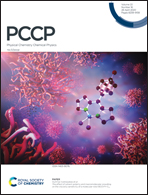A hybrid theoretical method for predicting electrokinetic energy conversion in nanochannels
Abstract
The traditional methods to predict electrokinetic energy conversion (EKEC) in nanochannels are mostly based on the Navier–Stokes (NS) equation for ionic flow and the Poisson–Boltzmann (PB) equation for charge distributions, which is questionable for ion transport through highly charged nanochannels. In this work, the classical density functional theory (cDFT) is used together with molecular dynamics (MD) simulation and the Navier–Stokes (NS) equation to predict the electrical current and the thermodynamic efficiency of electrokinetic energy conversion in nanochannels. By introducing numerical results for the slip length calculated from MD simulation, a significant increase of the electrokinetic current is predicted in comparison to that obtained from the traditional electrokinetic equations with the non-slip boundary condition, leading to the theoretical predictions of the thermodynamic efficiency for electrokinetic energy conversion in nanochannels in good agreement with recent experiments. The hybrid method predicts that maximum electrokinetic efficiency can be achieved by tuning the channel height and solution conditions including electrolyte concentrations, ion valences, and surface energies. The theoretical results provide new insights into pressure-driven electrical energy generation processes and helpful guidelines for engineering design and optimization of electrokinetic energy conversion.



 Please wait while we load your content...
Please wait while we load your content...